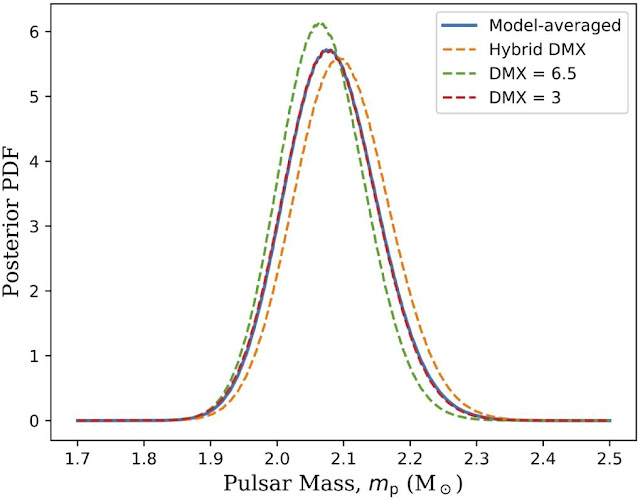Artist’s impression of how the pulses emitted by the pulsar PSR J0740+6620 are affected by the gravity of its white-dwarf companion. Credits:B. Saxton/NRAO/AUI/NSF
What does the inside of a neutron star — the incredibly dense remnant of an evolved star — look like? New observations of one of the most massive neutron stars provide some clues.
Mysterious Interior
With the mass of multiple Suns packed into the rough size of a city, neutron stars represent one of the most dense, exotic environments in the universe. We can’t create an equivalent environment on Earth, so we rely on theoretical models — constrained by observations — to understand how matter behaves under these extreme circumstances.
Different theoretical models predict different interior structures for neutron stars, each described by an equation of state. In turn, each equation of state predicts a different maximum mass that a neutron star can reach before the overwhelming crush of gravity causes it to collapse into a black hole.
The heaviest neutron stars we spot in the universe, then, can help us to set upper limits and rule out some equations of state, narrowing down which models of neutron star interiors are most likely.
The catch? Measuring the precise masses of objects located thousands of light-years away is difficult! Luckily, the universe occasionally offers up clever tricks for doing so.
Different theoretical models predict different interior structures for neutron stars, each described by an equation of state. In turn, each equation of state predicts a different maximum mass that a neutron star can reach before the overwhelming crush of gravity causes it to collapse into a black hole.
The heaviest neutron stars we spot in the universe, then, can help us to set upper limits and rule out some equations of state, narrowing down which models of neutron star interiors are most likely.
The catch? Measuring the precise masses of objects located thousands of light-years away is difficult! Luckily, the universe occasionally offers up clever tricks for doing so.
The posterior distribution of PSR J0740+6620’s measured mass, using several different models
Credit: Fonseca et al. 2021
Credit: Fonseca et al. 2021
A Delay from Gravity
Some highly magnetized neutron stars emit beams of light that regularly pulse across our line of sight as they rotate. If these incredibly precise cosmic clocks — pulsars — have a binary companion, and if we view that binary edge-on, then we have a unique opportunity for some mass measurements.
In such a system, the distortion of spacetime caused by the gravity of the companion object can affect the signal of the pulsar, such that the pulses arrive at Earth at slightly offset times. This effect, known as the Shapiro time delay, allows us to precisely measure the companion’s mass — which can then be used with the binary orbit to establish the pulsar’s mass.
In a recent study, a team of scientists led by Emmanuel Fonseca (McGill University, Canada; West Virginia University) have now used this approach with new observations of the pulsar PSR J0740+6620 to place the tightest constraints on its mass yet — and it’s a doozy.
Mass distribution of neutron stars in known binary systems (click to enlarge). PSR J0740+6620 is currently the heaviest neutron star with a precisely measured mass. Credit: Paulo Freire / Vivek Krishnan
Tipping the Scales
Fonseca and collaborators use observations from the 100-m Green Bank Telescope and the Canadian Hydrogen Intensity Mapping Experiment (CHIME) telescope to carefully model the Shapiro delay and measure the properties of PSR J0740+6620 and its companion, significantly improving upon previous measurements. The authors show that PSR J0740+6620 weighs in at 2.01–2.15 solar masses — confirming its status as the heaviest precisely measured neutron star currently known. They also confirm that the binary lies ~3,700 light-years away, and that the companion is an unusually cold white dwarf of just 0.25 solar mass.
Even more precise constraints — both on PSR J0740+6620 and other high-mass neutron stars — will be enabled by ongoing observations with currently technology, and by future studies using next-generation telescopes. Each improvement brings us a little closer to understanding the matter in these extreme objects.
Even more precise constraints — both on PSR J0740+6620 and other high-mass neutron stars — will be enabled by ongoing observations with currently technology, and by future studies using next-generation telescopes. Each improvement brings us a little closer to understanding the matter in these extreme objects.
Citation
“Refined Mass and Geometric Measurements of the High-mass PSR J0740+6620,” E. Fonseca et al 2021 ApJL 915 L12.doi:10.3847/2041-8213/ac03b8
By Susanna Kohler
By Susanna Kohler



